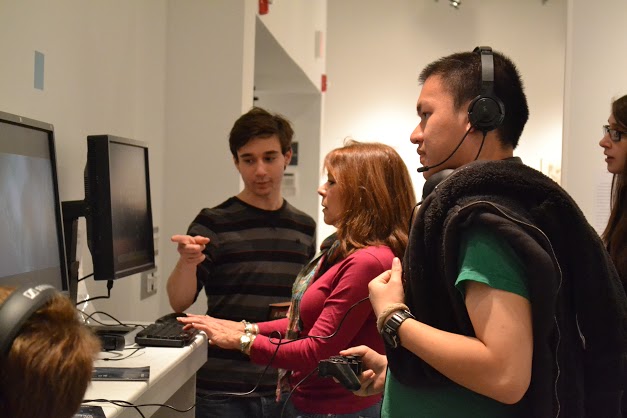By Ryan McElroy
Correspondent
Walking into the College’s new art gallery is like being transported into a digital world that takes students through different decades, worlds and experiences.
“A Palette of Pixels: The Evolving Art of Video Games” is the College’s current exhibition in the Art and Interactive Multimedia Building that takes viewers on a journey into video games throughout history.

The gallery opened with a reception on Wednesday, Oct. 21, with over 200 attendees, according to Emily Croll, the art gallery director.
Accompanying this gallery was a lecture titled “Press Play” by Gerard Marino, the composer of the “God of War” series, in the Mayo Concert Hall on Friday, Oct. 30. There was also a concert, “Pixel Music,” conducted by David Vickerman with Marino as a special guest conductor in Kendall Hall on the same day.
The exhibit is broken up into three eras. The first era spans from the late ’70s to early ’80s and shows games with big imagination, but basic technology. Croll said that the ambitious cover art for games like “Othello” and “Space Invaders” was too advanced for its time and could not be reflected in the games.
In era two, the games displayed were from the early 2000s. In this era, the technology improved and made it possible for graphics to become more realistic, such as those in the “God of War” saga, “Bioshock” and “Okami,” which indicates the transitional period in the artistic style in video games.
The newest generation of games is in era three, which contains deeper themes than in era one. This is evident in games like “Spate” — which shows life from the perspective of someone coping with an addiction to alcohol. Some of these modern games use old animation styles, like in “The Dream Machine,” which uses claymation.
“(It’s) interesting to see how some retro-minimalism has bled over into the art styles of modern indie games,” said Dom Portera, assistant curator of this exhibit and a junior interactive multimedia major. “Nowadays, game designers are creating games with all kinds of aesthetics — from pixilated and blocky to stunning realism — and use today’s technology to make both visually and thematically complex games.”

Portera and Croll worked with Chris Ault, the exhibit curator and associate interactive multimedia professor, to put the exhibit together.
“Ault developed the theme for the exhibition and identified video games that he was interested in presenting,” Croll said. “(Portera) did a lot of research tracking down the artists… then I contacted them and asked them if they would be willing to lend artwork to the exhibition. Then some of them, (like) the artists for ‘The Dream Machine,’ shipped their art from Sweden and the company that developed ‘Katamari Damacy’ shipped their art from Japan. It’s perhaps the farthest art has come to the gallery.”
Among the pieces sent in from around the world are video compilations of trailers created by Portera.
“I tried to pick the scenes that, when stitched together, best encapsulate the prevailing themes of the games, while also highlighting the variety of moods and visuals each game presents,” Portera said. “It was often a challenge capturing all of that in the videos while not giving away too much story-wise.”
Visitors can also play some of the games featured in the exhibit, like “Metamorphabet,” “Limbo” and “The Banner Saga,” which are among many other games highlighted in the gallery.
“A few of my favorites ended up in the exhibit, but ‘Journey’ stands out to me in how it captivates the player with a beautiful atmosphere, a sense of wonder and an emotional connection beyond any other I’ve experienced in a video game,” Portera said.
Aside from the emotional connections students can make to these games, Croll said that students can learn a lot from the gallery.
“Even if they know something about video games, they may not know the early history, they may not know the development,” Croll said. “And then there are a lot of people who know about the early Atari games and may not — these would be older people — but may not know about the more recent independent games.”
The exhibit is open from Wednesday, Oct. 21, to Sunday, Dec. 13. People can visit the gallery on Tuesdays through Thursdays, from noon to 7 p.m., and Sundays from 1 p.m. to 3 p.m.
Chelsea LoCascio and Samantha Altman contributed to this article







